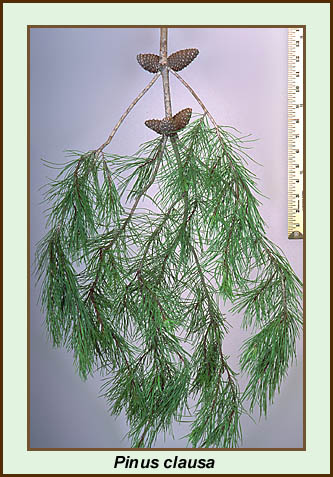Sand Pine
Pinus clausa
Family: Pinaceae
Natural History

Sand pine is also called scrub pine and in many older books, it is referred to as spruce pine, although it should not be confused with Pinus glabra, which is the more commonly known spruce pine. The natural range of sand pine is limited to parts of Florida and Alabama, where it grows well in the acidic soils that developed from ancient Pleistocene sand deposits.
The wood of sand pine is of limited commercial value, due to the small size and twisted form of the tree; however, it is sometimes used as pulpwood or fuel. The Choctahatchee variety, in the Florida panhandle, grows relatively straight and has been grown for Christmas trees in some parts of their range. Sand pine has an extensive, fibrous root system that helps to stabilize soils and prevent erosion. The trees are susceptible to insect damage, especially from bark beetles and sand pine sawflies, and may also suffer from mushroom root rot.
Sand pine is most often seen in dense, even-aged stands that require regular fire to open and release the cones. The Big Scrub region of central Florida has the largest stand of sand pine, encompassing 250,000 acres in the Ocala National Forest.
More than 20 threatened or endangered species of wildlife live in or utilize sand pine forests, including Florida scrub jays that sometimes nest in the branches. The heavily-branched trees provide cover and nesting sites for many songbirds, woodpeckers, and squirrels. Birds of prey perch in the trees to watch for small mammals and rodents that often feed on the seeds.
As more land is developed, natural stands of sand pine are disappearing, leaving these wildlife at increased risk. Sand pine is found primarily in central and northern Florida and parts of southeastern Alabama.
